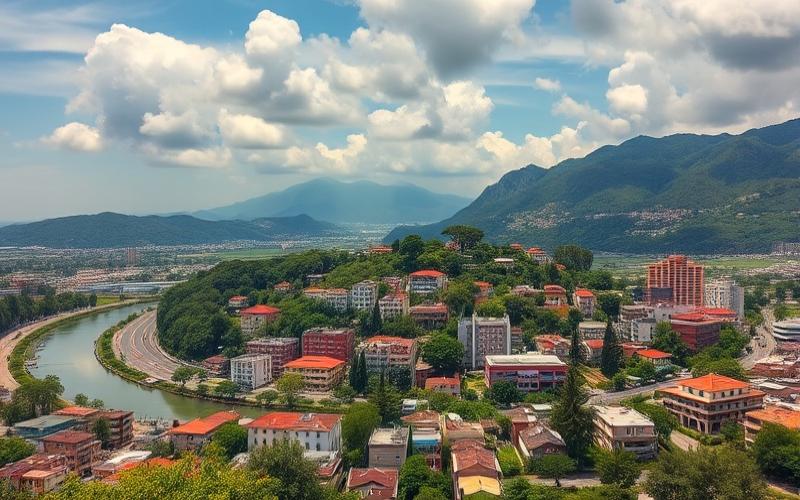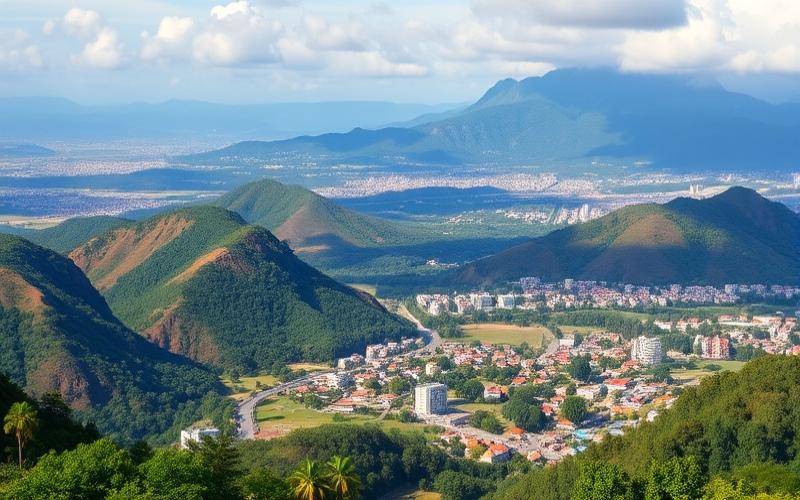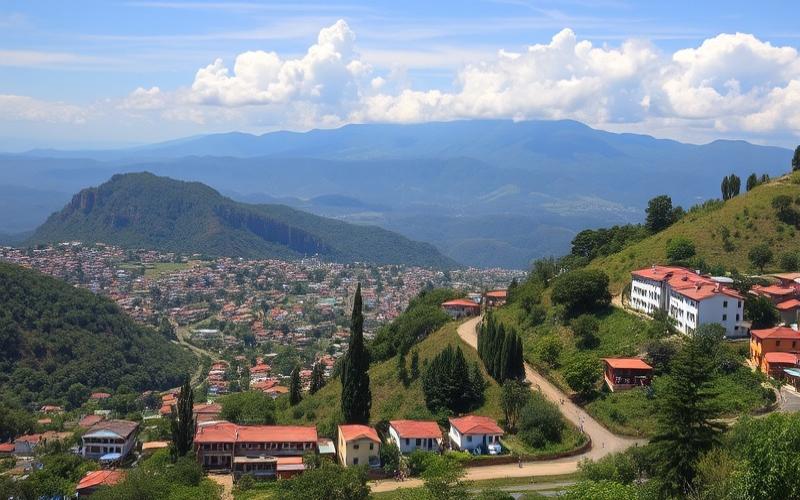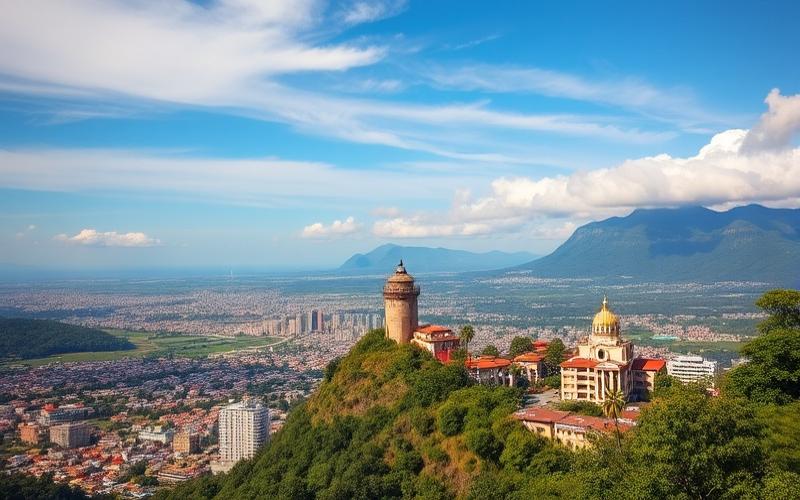
 Published on and written by Cyril Jarnias
Published on and written by Cyril Jarnias
El Salvador, often overlooked, is brimming with richly spiced and flavorful traditional dishes that will surprise even the most seasoned food enthusiasts.
For expatriates eager to immerse themselves in Salvadoran culture through its cuisine, our culinary guide offers a journey through local specialties like the famous pupusas, stuffed corn cakes that are a true national symbol, as well as lesser-known delights such as sweet and melt-in-your-mouth tamales de elote.
Exploring colorful markets overflowing with tropical fruits and exotic vegetables, or settling into picturesque comedores, those small family-run restaurants, every bite becomes an open door to the country’s history and traditions.
Whether you’re seeking comfort food or new taste experiences, this culinary immersion promises not only to satisfy your palate but also to make your stay in El Salvador an unforgettable adventure.
El Salvador’s Culinary Treasures: A Journey to the Heart of Local Flavors
Main Traditional Salvadoran Dishes and Their Preparation
| Dish | Main Ingredients | Story / Origin | Typical Home Preparation |
|---|---|---|---|
| Pupusas | Corn, cheese, beans, chicharrón, loroco | National dish, pre-Columbian heritage, declared national symbol in 2005 | Hand-kneaded corn dough, stuffed and cooked on a griddle, served hot with cabbage salad and tomato sauce |
| Tamales | Corn, chicken, vegetables, beans, banana leaves | Festive dish, Mesoamerican heritage, every family has its own recipe | Ground corn mixed with lard, stuffed, wrapped in banana leaves, steamed |
| Sopa de pata | Beef feet, vegetables (yucca, corn, cabbage), spices | Hearty soup, often prepared on weekends or for large gatherings | Long cooking of beef feet, addition of vegetables, served with tortillas and lime |
Typical Ingredients and Their Cultural Importance
- Corn: Foundation of Salvadoran cuisine, base for most dishes (pupusas, tamales, tortillas, atol).
- Red beans: Daily accompaniment, symbol of abundance.
- Fresh cheeses: Used in fillings, provide creaminess and flavor.
- Meats (pork, chicken, beef): Festive ingredients, often shared during large family meals.
- Local vegetables (yucca, chayote, loroco, chipilín): Essential for dish diversity and showcase the country’s biodiversity.
- Banana leaves: Used for wrapping tamales, add subtle aroma.
Traditional Beverages
- Atol de elote: Warm drink made from sweet corn, enjoyed for breakfast or during celebrations.
- Salvadoran horchata: Sweet drink made from morro seeds, cinnamon and milk, refreshing and ubiquitous.
- Salvadoran coffee: Renowned for its quality, often served after meals.
Iconic Desserts
- Empanadas de plátano: Plantain mash stuffed with milk or sweet beans, breaded and fried.
- Riguas: Sweet corn cakes cooked in banana leaves, served warm.
- Salvadoran quesadilla: Cheese cake, soft and slightly sweet.
Stories About Origins and Social Aspects
According to oral tradition, pupusas originated in Pipil indigenous communities; every village has its renowned “pupusería,” and their preparation is often a moment of sharing between generations.
Tamales are prepared as a family during celebrations, with everyone participating in the wrapping, making it a collective and festive activity.
Sopa de pata, typically enjoyed at large gatherings, symbolizes Salvadoran hospitality: a generous dish meant for sharing.
Practical Tips for Expatriates
- To taste the best pupusas, prioritize small family “pupuserías” or street stands, especially in the evening.
- Local markets (Mercado Central in San Salvador, Mercado de Santa Tecla) offer a wide variety of homemade tamales and soups.
- Many cooking workshops (pupusa or tamale workshops) are offered by cultural associations or directly in homes; they provide authentic immersion and discovery of traditional techniques.
- It’s common to be invited to share a meal; don’t hesitate to accept, as friendliness and sharing are at the heart of Salvadoran culture.
Good to Know:
Pupusas, stuffed with beans or cheese, are often accompanied by horchata, a refreshing drink made from morro seeds; for the best ones, head to a local market and participate in cooking workshops to discover the secrets of tamales.
Salvadoran cuisine is above all a sharing experience, where the table brings together families, friends and neighbors around simple, generous dishes rich in history.
From Farm to Table: Exploring Traditional Food Markets
The Mercado Central in San Salvador is a true bustling labyrinth, overflowing with colorful stalls mixing vendors of tropical fruits, spices, flowers, meats and authentic street food. Nearby, the Mercado Nacional de Artesanías offers a wide variety of crafts, from traditional pottery to embroidered textiles, reflecting Salvadoran cultural richness.
Traditional food markets play a central role in the daily life of Salvadorans. They are meeting places, exchanges and transmission of culinary knowledge, where social and family bonds are woven. They embody community spirit, solidarity and preservation of traditions.
Star Products of Salvadoran Markets
- Pupusas: Corn cakes stuffed with cheese, beans or meat, national emblem prepared before your eyes.
- Riguas: Sweet corn pancakes often served with fresh cheese.
- Empanadas de dulce: Sweet plantain fritters filled with cream or dulce de leche.
- Tamales: Corn dough cooked in banana leaves, filled with chicken, pork or vegetables.
- Tropical fruits: Mangoes, pineapples, papayas, watermelons, pitayas, depending on season.
- Plantains and other local tubers.
- Traditional beverages: agua fresca (e.g. piña con leche), horchata, tamarind.
| Product | Availability Season | Influence on Local Cuisine |
|---|---|---|
| Mango | March to June | Used in juices, salads or desserts |
| Watermelon | December to April | Refreshing, often in juice or slices |
| Pupusas | Year-round | Daily dish, symbolic and festive |
| Riguas | Corn season (June to August) | Prepared fresh at harvest |
| Plantains | Year-round | Base for many sweet/savory dishes |
Unique Sensory Market Experience
- Vibrant colors of stalls, traditional fabrics and clothing.
- Intoxicating scents of grilled corn, ripe fruits, spices and freshly roasted coffee.
- Sound of the crowd, negotiations, vendors calling out, street musicians.
- Constant animation: cooking demonstrations, children running between stalls, warm and authentic atmosphere.
Tips for Exploring Markets
- Prefer morning hours to enjoy product freshness and lively atmosphere.
- Learn a few Spanish words or let yourself be guided by a local to facilitate exchanges.
- Negotiate prices respectfully, a smile always facilitates transactions.
- Bring small bills for purchases.
- Respect customs: it’s common to greet and thank vendors, and to sample offered products.
- To get there, prefer taxis or public transportation, as parking is often difficult near markets.
Good to Know:
San Salvador’s markets, like the Mercado Central, overflow with fresh local products available seasonally, such as pupusas and tropical fruits, offering a unique sensory immersion with its intoxicating aromas and constant buzz of stalls. For an optimal experience while respecting local customs, it’s recommended to visit early in the morning, bring a reusable bag, and chat with vendors to discover daily specialties, while directly supporting local farmers.
Traditional markets play a key role in supporting small farmers and local artisans, ensuring direct and fair compensation. They promote food sustainability by valuing short supply chains, product seasonality, and preservation of local varieties. These places are essential to the country’s food resilience and transmission of ancestral culinary knowledge.
Don’t miss: tasting a freshly prepared pupusa, wandering among tropical fruit stalls, and interacting with artisans to better understand El Salvador’s soul.
Iconic Restaurants and Contemporary Trends: Where to Eat in El Salvador
Salvadoran culinary tradition holds a central place in national identity and today fits into a global movement valuing authentic cuisines. Founded on local products like corn, beans, squash and pork, it offers a diversity of dishes where indigenous heritage meets Spanish influences. This richness increasingly attracts international clients seeking authenticity, while adapting to new global trends, particularly the valorization of organic products, fusion cuisine and the growing importance of street food.
Iconic Restaurants Not to Miss:
| Restaurant Name | Specialties & Assets | Practical Tips |
|---|---|---|
| Pupusería Olocuilta | Artisanal pupusas, local atmosphere | Reservation not required, ideal for casual meal. Budget: $2-5 per person. |
| El Xolo (San Salvador) | Reimagined traditional cuisine, tamales | Reserve for dinner, dishes $8-15. Multilingual service. |
| La Pampa | Grilled meats and ceviches, elegant setting | Reservation recommended weekends. Price: $15-30. Suitable for international tastes. |
| El Chalateco | Typical dishes (pupusas, fried yuca, empanadas) | Friendly atmosphere, few formalities. Dishes: $5-10. |
| Beto’s (La Libertad) | Fish & seafood, ocean view | Arrive early for table with view. Budget: $10-25. |
Typical Dishes to Absolutely Discover:
- Pupusas: Thick corn cakes stuffed (cheese, beans, chicharrón, loroco). National dish, available everywhere from upscale restaurants to street stands.
- Tamales: Corn dough filled (chicken, vegetables, beans or chipilín), cooked in banana leaves.
- Yuca frita con chicharrón: Fried cassava with crispy pork, served with chimol sauce.
- Sopa de pata: Thick soup made from beef feet and local vegetables.
- Riguas: Corn cakes cooked in banana leaves, often served with cheese.
Contemporary Trends:
- Fusion cuisine: Innovative chefs blend local flavors with international techniques, creating menus suited for cosmopolitan clientele.
- Local and organic ingredients: More restaurants prioritize short supply chains, offering dishes based on organic products from small producers.
- Street food scene: Proliferation of food trucks and gourmet markets highlights creativity of young chefs, offering expatriates authentic and affordable immersion.
Tips for Expatriates:
- Most traditional restaurants are very accessible, without formal dress code. Menus often offer vegetarian options and adaptations for less spice-tolerant palates.
- Pupuserías and street stands are ideal for quick, economical meals, but it’s advised to go early (between 6-8 PM) to enjoy fresh products.
- In more popular establishments, reservations are recommended, especially on weekends or for groups.
- Prices remain very affordable compared internationally, allowing exploration of local gastronomy without breaking the bank.
Practical Tip: For an optimal experience, combine discovery of an iconic restaurant with a stroll through a local market or tasting at a street stand. This will allow you to grasp the full diversity and friendliness of Salvadoran cuisine.
Good to Know:
For an authentic experience, visit “Los Ranchos” for its traditional pupusas and discover “Pampas” for innovative fusion cuisine; remember to reserve in advance, especially on weekends, and plan an average budget of $10-30 per meal.
Table Etiquette: Tips for Integrating in Various Cultural Contexts
Meals in El Salvador are a central moment of social and family life, marked by specific customs and great conviviality. Participating in family or group meals is a sign of respect and integration, as the collective dimension of meals strengthens social and family bonds.
| Cultural Practice | Meaning and Adaptation Tips |
|---|---|
| Sharing meals with family | Shows importance of cohesion and respect for elders. Always accept an invitation, even for simple coffee. |
| Serving guests | Host or hostess often serves guests. Wait to be served or politely offer to serve others. |
| Making a toast | Rare during daily meals, but may occur during special occasions. Toast expresses gratitude and joy of being together. |
| Leaving a little food | May indicate being satisfied and having enjoyed the meal. Avoid finishing your plate completely to not give impression of still being hungry. |
| Complimenting the host | Do it simply and sincerely, for example: “This meal was delicious, thank you very much!” |
Traditional Dishes Frequently Served During Typical Meals:
- Pupusas: Corn cakes stuffed (cheese, beans, pork…), accompanied by curtido (cabbage salad) and tomato sauce.
- Tamales: Corn dough filled (meat, vegetables) cooked in banana leaves.
- Chicken soup: Rich broth with vegetables, chicken, rice and herbs.
- Fried yuca: Fried cassava often accompanied by chicharrón (fried pork).
- Seafood: Shrimp ceviche, fried fish, shrimp cocktail, especially on the coast.
- Desserts: Plantain empanadas, nuegados (honey fritters), pastelitos de leche.
Typical beverages: horchata (made from rice and spices), atol de elote (warm corn drink), coffee.
Practical Tips for Adapting Respectfully:
- Punctuality: Be on time, but wait for the host to start the meal.
- Dress code: Opt for neat and modest attire. Overly casual or flashy clothing should be avoided, especially during family meals or special occasions.
- Conversation topics to avoid:
- Local politics and controversial subjects.
- Economic or security problems.
- Criticism of local cuisine or traditions.
- Appreciated topics:
- Family, travel, culture, dishes you’ve enjoyed.
- Preferred gestures:
- Thank the host warmly.
- Participate in discussion without monopolizing conversation.
- Accept at least a small portion of each offered dish.
Key takeaway:
Actively participating in the meal, showing appreciation for hospitality, and adopting an open and respectful attitude are essential for harmoniously integrating into Salvadoran culture.
Good to Know:
During traditional meals in El Salvador, make sure to actively participate in conversations and compliment the host sincerely, while avoiding sensitive topics like politics; leave a small portion on your plate to show you’re satisfied, and wear casual but neat attire to blend into the friendly atmosphere.
Disclaimer: The information provided on this website is for informational purposes only and does not constitute financial, legal, or professional advice. We encourage you to consult qualified experts before making any investment, real estate, or expatriation decisions. Although we strive to maintain up-to-date and accurate information, we do not guarantee the completeness, accuracy, or timeliness of the proposed content. As investment and expatriation involve risks, we disclaim any liability for potential losses or damages arising from the use of this site. Your use of this site confirms your acceptance of these terms and your understanding of the associated risks.























